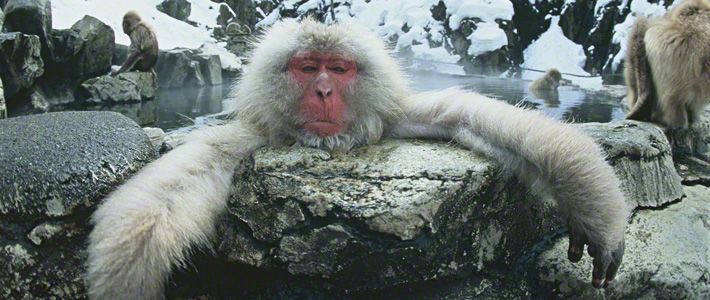
Hot Springs and Snow Monkeys: Four Seasons in “Hell Valley” (Photos)
Guide to Japan Travel- English
- 日本語
- 简体字
- 繁體字
- Français
- Español
- العربية
- Русский
Jigokudani, literally “hell valley,” is an area in the north of Nagano Prefecture famous for the monkeys that like to take a dip in its onsen waters. The Yokoyugawa river flows down from the Shiga Highlands in Jōshin'etsu-kōgen National Park into a ravine surrounded by steep cliffs where hot springs well up constantly from underground. Macaque monkeys have been living in this area since ancient times. In 1964, the Jigokudani Yaen-Koen, also known as Jigokudani Monkey Park, opened with the aim of limiting disturbances to the macaques’ habitat, which is why visitors are forbidden from feeding or touching the monkeys.
Monkeys Take Up Bathing
After the park opened, some monkeys were found enjoying a soak in the outdoor baths of a nearby ryokan (inn). It was decided to make the monkeys a pool of their own within the park. This was completed in 1967, and before long other monkeys were using it. Researchers and tourists from Japan and around the world now flock to Jigokudani to see the monkeys that have acquired this unique habit.
Winters are harsh in this part of Japan, with snow piling up to over two meters high and the temperature rarely climbing above zero. All sorts of macaques gather in the park’s hot spring pool to thaw out their chilled bodies. There is an older monkey with snow on his head, his eyes shut in a blissful expression. Not far from him, a mother and baby snuggle up together. Meanwhile, a female monkey dozes off as she warms up in the pool.
From the looks on their faces, it’s clear that the monkeys are enjoying their bath. But one monkey off the side refuses to get in and join the others. Maybe he just doesn’t like hot springs. But the onsen aficionados among the monkeys don’t mind soaking for two hours, so by the time they climb out they almost faint from dizziness.
Four Seasons in the Monkey Park
Baby monkeys are born in the spring, when the trees begin to bud and food is easy to find. A female monkey generally gives birth to one baby every other year. Monkeys are born with a full coat of fur and their eyes open. For the first week or so the babies cling constantly to their mothers, but after that they start to walk unsteadily on all fours.
It’s fascinating to watch a monkey take its first faltering steps away from its mother, then tumble and cry out in distress. You can’t help feeling a warm glow at the sight of its mother rushing to help the baby, her eyes brimming over with affection.
Amid the deep green scenery of summer, the monkeys molt, replacing their winter coats with short-haired fur to suit the warmer weather. Adults try to escape the heat by resting in the shade, while the little ones burn off their energy swimming in the pool or chasing each other along the river bank. In autumn, the monkeys gather chestnuts, grapes, and other nutritious food from the forest to help them get through the winter. When the trees in the surrounding mountains begin to change color, mating season begins. Male monkeys, their faces and rumps a deeper red than usual, desperately seek out partners.
By photographing the lives of these monkeys throughout the year, they have come to seem more like people than animals to me, My hope is that Jigokudani Monkey Park, which celebrates its 50th anniversary this year, can be maintained as an environment where people can learn more about and gain a better appreciation of monkeys.

February: An older monkey enjoying a long soak.

March: A sudden urge to doze while warming up.

February: I don’t want to get out of the bath in this weather!

January: Although he looks cold, this monkey just doesn’t seem to want to get in the water.

January: A young monkey nibbles on the small portion of barley the monkeys in the park are fed at regular times.

March: A family relaxes around a young monkey in the pool.

February: The snow on either side of Yokoyugawa makes it narrower and easier to jump across. Each morning the monkeys come down from the mountains to be fed and use the pool.

May: New-born babies cling to their mothers wherever they go.

July: Baby monkeys romp together while a mother seeks refuge from the heat in the shade.

September: This mother and child may look like they are smiling, but actually they are responding to a threat from other monkeys off-camera.

September: A monkey jumps up to look bigger during a squabble over food.

October: A mother with her baby clutching her chest goes up the cliff in search of food.

November: In late autumn, mating season begins.

February: Young monkeys jump energetically through the trees in the milder temperature after a blizzard.

January: A fight in the snow over food. Usually such scuffles are brief scuffle, but sometimes serious injuries occur.

January: The bath is popular on a chilly day like today.

January: Although the fur on its head is frozen, the rest of this monkey’s body is nice and warm.

December: Monkeys not accustomed to the cold huddle together on a snowy day in December.
(Original Japanese article and photographs by Kobayashi Hideki posted on October 22, 2014. )
tourism nature onsen animal Hot Springs Nagano photographs snow monkeys Nagano Prefecture monkeys photo Jōshin'etsu-kōgen National Park Jigokudani Monkey Park



